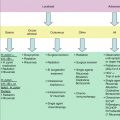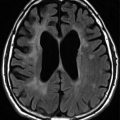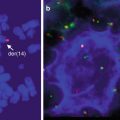
Fig. 10.1
Primary mediastinal B-cell lymphoma: (a) H&E staining, consists of the neoplastic large cells with clear cytoplasm, (b) fibrotic bands with compartmentalising alveolar fibrosis, (c) tumour cells express CD30 on their membrane, (d) typically shows CD20-positive cells, (e) tumour cells also show strong cytoplasmic staining for MAL antigen, (f) tumour cells are frequently BCL6 and IRF4 positive, (g) surface and cytoplasmic staining for immunoglobulin are mostly negative, and (h) the transcription factors OCT-2 and BOB-1 are usually expressed (Reprinted from Pileri et al. (2003). With the permission)
10.3.4 Diagnostic Criteria
The main differential diagnoses are classical Hodgkin lymphoma and diffuse large B-cell lymphoma (Table 10.1). Classical Hodgkin lymphoma can be distinguished from PMBCL by histological features such as abundant infiltration with granulocytes and small sized lymphocytes as well as histiocytes in the former. In addition, classical Hodgkin lymphoma expresses CD15 and less often a full set of B-cell markers. The B-cell transcription factor PAX5 is only weakly expressed in Hodgkin lymphoma, in contrast to PMBCL. MAL has been reported to be specifically expressed in PMBCL but is rather a difficult marker to stain for in routine practice (Copie-Bergman et al. 2002). Some cases with either morphological features of PMBCL but immunophenotypical features of classical Hodgkin lymphoma or vice versa do not allow a final diagnosis and are classified as B-cell lymphoma, unclassifiable, with features intermediate between diffuse large B-cell lymphoma and classical Hodgkin lymphoma, or the so-called mediastinal grey zone lymphoma (Traverse-Glehen et al. 2005). The differential diagnosis with diffuse large B-cell lymphoma, NOS is not always easy. The distinct morphological features of PMBCL, such as clear cell proliferation and sclerosis, may be difficult to evaluate on small biopsies, and there is a lack of well-defined diagnostic criteria that can be routinely applied. The expression of CD23 in PMBCL may be useful in that respect (Calaminici et al. 2004). Recently, it was also demonstrated that immunohistochemical analysis of TNFAIP2, expressed by most cases of PMBCL and Hodgkin lymphoma but not by diffuse large B-cell lymphoma, NOS, may be useful for making a correct diagnosis (Kondratiev et al. 2011). Gene expression analysis allows for an improved distinction between PMBCL and diffuse large B-cell lymphoma, NOS, but can as yet not be used in clinical practice (Rosenwald et al. 2003).
Table 10.1
Comparison of the pathological and immunophenotype features of primary mediastinal large B-cell lymphoma (PMBCL), diffuse large B-cell lymphoma (DLBCL), nodular sclerosis classical Hodgkin lymphoma (NScHD), and mediastinal grey zone lymphoma (MGZL)
Features | PMBCL | DLBCL | NScHL | MGZL |
|---|---|---|---|---|
Morphology | Sheets of large cells; clear cells ; no inflammatory | Sheets of large cells with variable aspects | Lacunar Hodgkins Reed-Stenberg cells Inflammatory polymorphous infiltrate | Sheets of pleomorphic large cells; Lacunar Hodgkins Reed Stenberg cells; sparse inflammatory infiltrate |
Sclerosis | 70–100 % (alveolar, fine bands) | Absent | 100 % (large bands) | Focal fibrous bands |
CD45 | Positive | Positive | Negative | Positive |
CD30 | Positive weak (70–80 %) | Rare (anaplastic variant) | Positive | Positive |
CD15 | Negative | Negative | Positive | Positive |
CD20 | Positive | Positive | Negative | Positive |
CD79a | Positive | Positive | Usually negative | Positive |
PAX-5 | Positive | Positive | Weak positive | Positive frequently |
Immunoglobulin | Negative | Positive | Negative | Negative |
BOB-1 | Positive | Positive | Negative | Positive frequently |
OCT-2 | Positive | Positive | Negative | Positive frequently |
MAL expression | 60–70 % | <10 % | <20 % | 30–40 % |
10.3.5 Genetic Characteristics
Gene alterations are diverse, and copy number gains of REL, PDL1/PDL2, JAK2, and JMJD2C; chromosomal rearrangement of CIITA; mutations of SOCS1, STAT6, TNFAIP3, MYC, and TP53; or promotor hypermethylation of p16/INK may be seen (Steidl and Gascoyne 2011). The common consequences of these changes are activation of JAK-STAT signalling and NFkB pathways, resulting in increased cell proliferation and survival. In addition, downregulation of HLA class II molecules as well as overexpression of PD-1 ligands as a consequence of the genetic changes cited above may allow PMBCL to escape immune surveillance. Interestingly, gene expression studies have shown a remarkable overlap of highly expressed genes and gene changes between PMBCL and Hodgkin lymphoma (Rosenwald et al. 2003; Steidl and Gascoyne 2011). Not surprisingly, the differential diagnosis between PMBCL and mediastinal Hodgkin lymphoma can be difficult and virtually impossible in some cases (Traverse-Glehen et al. 2005). The latter cases are called B-cell lymphoma, unclassifiable, with features intermediate between diffuse large B-cell lymphoma, and classical Hodgkin lymphoma, also known as “mediastinal grey zone lymphoma.”
10.4 Clinical Presentation
10.4.1 Clinical Features
Primary mediastinal large B-cell lymphoma normally presents with a bulky tumour in the anterior mediastinum that is rapidly progressive and gives rise to local compressive effects including dyspnea, cough, dysphagia, and superior vena cava obstruction. Up to one-half of patients have symptoms and signs of superior vena cava syndrome, thoracic and neck vein distension, facial oedema, conjunctival swelling, and occasionally arm oedema. This results in relatively early presentation so that at diagnosis, most patients (around 80 %) have stage I or II disease. The mediastinal tumour is frequently bulky, being over 10 cm in two-thirds of patients, and infiltrating the lung, chest wall, pleura, and pericardium (Falini et al. 1995; Armitage and Weisenburger 1998). Pleural or pericardial effusions are present in one-third of cases (Lazzarino et al. 1997; Zinzani et al. 2001). Breast oedema is common, and hoarseness may reflect recurrent laryngeal nerve damage (Fig. 10.2). Despite the local invasiveness, distant spread is infrequent at the outset, and even spread to the supraclavicular nodes is unusual at presentation. Extranodal sites may, however, be involved, particularly in cases of disease recurrence, with an unusual propensity for involvement of the kidneys, adrenal glands, liver, and ovaries (Haioun et al. 1989; Lazzarino et al. 1993; Bishop et al. 1999). Systemic symptoms, mainly fever or weight loss, are present in a minority of cases. Bone marrow infiltration at presentation is rare, but elevated lactate dehydrogenase levels are observed in two-thirds of patients. MGZL shows similar clinical features but, compared to PMBCL, is more common in young men and more often has extranodal involvement (Table 10.2).


Fig. 10.2
CXR (a) and CT (b) scan from a female patient presenting with PMBCL. Note the large anterior mediastinal mass, with areas suggestive of central necrosis. Marked breast oedema is present
Table 10.2
Comparison of the clinical features of: primary mediastinal large B-cell lymphoma (PMBCL), diffuse large B-cell lymphoma (DLBCL), nodular sclerosis classical Hodgkin lymphoma (NScHD), and mediastinal grey zone lymphoma (MGZL)
Features | PMBCL | DLBCL | cHL | MGZL |
|---|---|---|---|---|
Female/male ratio | 2:1 | 1:1 | 1:1 | 1:2 |
Median age | 35 | 55 | 28 | 35 |
Stage I–II | 70–80 % | 30 % | 55 % | 70–80 % |
Mediastinal invol. | All | 20 % | 80 % | All |
Extranodal sites | Uncommon | Common | Uncommon | Uncommon |
Bone marrow | 2 % | 10–15 % | 3 % | 3 % |
Elevated LDH | 70–80 % | 50 % | Rare | 70–80 % |
B symptoms | <20 % | 50 % | 40 % | 40 % |
Bulky disease | 70–80 % | 10–15 % | 50 % | 70–80 % |
10.4.2 Diagnostic and Staging Procedures
The complete staging workup for PMBCL is the same as that routinely used for nodal lymphoma. It includes an accurate physical examination, complete hematologic and biochemical examinations, total body computerised tomography, and bone marrow biopsy. The staging system used is the standard Ann Arbor classification (Carbone et al. 1971). A diagnostic tissue sample can be obtained by mediastinoscopy, biopsy of the tumour mass through the supraclavicular fossa, anterior mediastinotomy, or minithoracotomy. It is important to consider the anaesthetic risk for patients with critical airways narrowing by anterior mediastinal tumours: it may be preferable to obtain a needle core biopsy by a percutaneous route under local anaesthesia than to obtain a large biopsy but have a patient who cannot be extubated following the procedure because of airway compromise.
PMBCL shows almost universal avidity for [18F]-2-fluoro-2-deoxyglucose, making positron emission tomography (FDG-PET) an effective means to assess disease extent and to characterise residual masses at the completion of treatment. The extent of experience with this technique is, however, too limited to permit major changes to therapy based upon FDG-PET scans at present, pending the results of prospective trials.
10.4.3 Prognostic Factors
The utility of the International Prognostic Index (IPI) in PMBCL is limited by the age distribution of the disease and its usual confinement to the mediastinum. This is reflected in the observation that half of patients have low IPI scores at presentation (Abou-Elella et al. 1999). The age-adjusted IPI has similarly been reported to be of limited predictive value in PMBCL. This may reflect differences between studies, assigning patients as either stage IV or stage 2E when contiguous extranodal sites such as the lung are involved (Todeschini et al. 2004; Hamlin et al. 2005; Savage et al. 2006). Elevated LDH to more than twice the upper limit of normal, age over 40, and performance status ≥2 all correlated with reduced survival in a population-based series from British Columbia (Savage et al. 2006), whilst in a large series from the International Extranodal Lymphoma Study Group (IELSG), male sex, poor performance status, and advanced-stage disease were significant negative predictors (Zinzani et al. 2002). Recent gene expression studies have suggested that low expression of major histocompatibility (MHC) class II genes correlate with a poor outcome (Roberts et al. 2006).
10.5 Treatment and Outcome
The first line of treatment and its outcome are critical in managing PMBCL. Therapy for recurrence or progressive disease is of strictly limited efficacy (Todeschini et al. 2004; Savage et al. 2006; Kuruvilla et al. 2008) making curative therapy at the first attempt even more important for this type of lymphoma. It is, however, important to strike an appropriate balance between the delivery of the highest possible cure fraction and minimising the long-term morbidity for this young population. A number of choices have to be made, including the initial chemotherapy/immunochemotherapy and whether there might be a benefit from high-dose therapy in first remission. The role of consolidation radiotherapy to the mediastinum is especially controversial.
10.5.1 Choice of Initial Treatment Regimen
There is broad agreement that for conventional DLBCL, the standard of care is the R-CHOP regimen. Prior to the introduction of rituximab, no advantage was demonstrated for the use of third-generation anthracycline-containing regimens over conventional CHOP for DLBCL in general (Fisher et al. 1993), but some retrospective series in PMBCL suggested that superior outcomes might be achieved with latter generation regimens (Todeschini et al. 2004). The largest series was from the IELSG, which reviewed the outcomes of 426 previously untreated patients with PMBCL (Zinzani et al. 2002). Most of the patients that were treated with a third-generation regimen received MACOP-B (n = 204), the rest either VACOP-B (n = 34) or ProMACE CytaBOM (n = 39). Although the complete response rate was similar between the third-generation subgroup and those treated with conventional CHOP or CHOP-B, the relapse rate at 3 years was significantly lower in the third-generation group (12 % vs. 23 %; P = 0.02), and the projected 10-year overall and progression-free survival were superior at 71 and 67 %, compared to 44 and 33 % (P = 0.0001 and P = 0.0003, respectively). The British Columbia group carried out a population-based retrospective analysis of 153 patients with PMBCL whose treatment was determined by era-specific guidelines (Savage et al. 2006). Between 1980 and 1992 MACOP-B or VACOP-B was used, switching to CHOP between 1992 and 2001 and then to rituximab with CHOP (R-CHOP) thereafter. The overall survival for the cohort was 75 % at 5 years, with the overall survival at 5 years being 87 % for those treated with MACOP-B/VACOP-B, significantly higher than the 71 % for those patients treated with CHOP (P = 0.048). Comparison of the baseline characteristics, however, demonstrated a greater number of poor risk patients in the CHOP group. In the multivariate analysis for overall survival, the type of chemotherapy regimen showed a trend towards improved outcomes, but this was not statistically significant.
Stay updated, free articles. Join our Telegram channel

Full access? Get Clinical Tree







